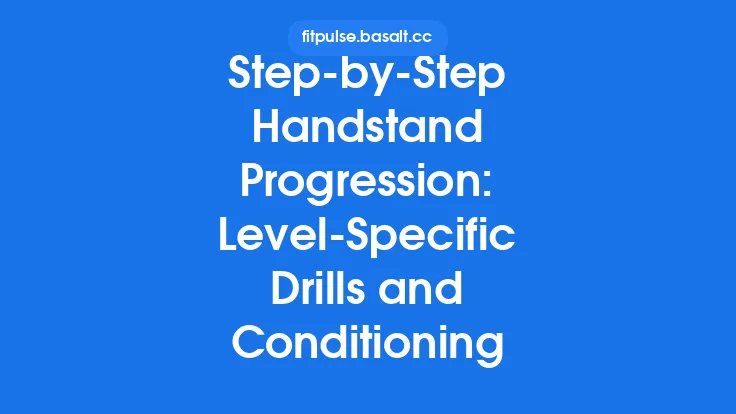Handstand push‑ups (HSPUs) are one of the most demanding upper‑body movements in bodyweight training, requiring a blend of shoulder strength, core stability, balance, and proprioception. Mastering them is a multi‑stage journey that begins with the safety net of a wall and culminates in a fully freestanding, controlled press. This guide walks you through every logical step, explains the underlying biomechanics, and provides concrete programming tools so you can progress methodically and avoid injury.
1. The Biomechanical Blueprint
Before diving into specific progressions, it helps to understand what the body is actually doing during a handstand push‑up.
| Component | Primary Muscles | Secondary Muscles | Key Joint Motions |
|---|---|---|---|
| Press | Deltoid (anterior), triceps brachii, upper pectoralis major | Serratus anterior, rotator cuff (supraspinatus, infraspinatus, subscapularis, teres minor) | Shoulder flexion/extension, elbow extension |
| Stabilization | Trapezius (upper/middle), rhomboids, levator scapulae | Core (rectus abdominis, obliques, transverse abdominis), hip flexors | Scapular upward rotation, posterior tilt of the thoracic spine, lumbar neutral |
| Balance (Freestanding) | Same as above + proprioceptive muscles of the wrist and forearm | Small hand‑intrinsic muscles, foot/ankle stabilizers (if using a “handstand on a wall” for balance) | Fine‑tuned adjustments at the wrist, shoulder, and trunk |
Why it matters: A solid press requires the shoulder girdle to move through a safe range of motion while the scapula remains stable. Freestanding balance adds the need for rapid, low‑amplitude corrections, which are trained by progressively reducing wall reliance.
2. Prerequisite Strength & Mobility Checklist
Progressing to advanced HSPU work is unsafe without a baseline of strength and flexibility. Verify that you can comfortably meet the following criteria before moving past the “wall‑supported” stage.
Strength Benchmarks
- Strict Pike Push‑Up: ≥ 12 reps with full range (head to floor)
- Wall‑Supported Handstand Hold: ≥ 45 seconds with scapular control (no “wallowing”)
- Strict Dips: ≥ 10 reps (parallel bars or rings)
- Core: Hollow body hold ≥ 60 seconds, L‑sit hold ≥ 20 seconds
Mobility Benchmarks
- Shoulder Flexibility: Able to place forearms on the ground in a deep pike without excessive arching of the lower back.
- Thoracic Extension: 30°–40° of extension measured with a wall‑mounted inclinometer or a simple “wall slide” test.
- Wrist Extension: Comfortable with 30°–40° of extension while bearing weight (use a light dumbbell or a wall‑supported handstand to test).
If any of these are lacking, incorporate targeted accessory work (e.g., banded shoulder dislocates, thoracic foam‑rolling, wrist stretches) before attempting the next progression.
3. Wall‑Supported Handstand Push‑Up Variations
The wall provides a safety net for both balance and load distribution. Begin with the most basic version and gradually increase difficulty.
3.1. Wall‑Supported Handstand Hold (Static)
- Goal: 60 seconds with scapular upward rotation and no “wallowing.”
- Cue: “Push the floor away” to engage the serratus and keep the shoulder blades active.
3.2. Wall‑Supported Handstand Shoulder Taps
- Reps: 3 × 5 taps per side.
- Purpose: Introduces unilateral load, improves proprioception, and trains the ability to shift weight without losing balance.
3.3. Wall‑Supported Handstand Push‑Up (Full Range)
- Setup: Hands placed shoulder‑width apart, feet against the wall.
- Depth: Lower until the head lightly touches the floor (or a padded mat).
- Progression: Start with a box or stack of plates under the head to reduce range, then gradually remove the support.
3.4. Wall‑Supported Handstand Push‑Up with Deficit
- Method: Place a small platform (e.g., a 2‑inch yoga block) under the hands, increasing the range of motion.
- Tip: Only add deficit once you can comfortably complete 8–10 full‑range reps with perfect form.
3.5. Wall‑Supported Handstand Push‑Up with Tempo
- Tempo Scheme: 3‑second eccentric (lowering), 1‑second pause at the bottom, explosive concentric.
- Why: Slower eccentrics build eccentric strength, a key factor for freestanding control.
4. Transitioning to Partial Freestanding
The goal here is to reduce reliance on the wall while preserving the press mechanics. The following drills gradually shift the center of gravity away from the wall.
4.1. Wall‑Walks (Handstand Entry)
- Execution: From a plank, walk feet up the wall and hands back toward the wall until you reach a handstand.
- Progression: Reduce the distance between hands and wall by stepping back a few inches each rep.
4.2. “Kick‑to‑Handstand” with Light Wall Contact
- Setup: Place a foam pad a few inches away from the wall. Kick up, allowing the heels to lightly touch the pad for a brief moment before pulling them away.
- Goal: 5–8 reps where the wall contact is under 1 second.
4.3. Freestanding Handstand Holds (Wall‑Free)
- Target Time: 10–15 seconds initially, building to 30 seconds.
- Cue: “Squeeze the floor with your hands, push the ground away.”
- Progression: Add a slight “pike” (hip flexion) to make the hold easier, then straighten.
4.4. “Box‑Supported Freestanding HSPU”
- Equipment: Place a sturdy box or low platform (6–12 inches) under the head. Perform a handstand push‑up with feet off the wall, using the box to limit depth.
- Purpose: Bridges the gap between wall‑supported depth and full freestanding range.
4.5. “Negative Freestanding HSPU”
- Method: Kick up into a freestanding handstand, then slowly lower to a pike position (head near the floor) and drop the feet. Reset and repeat.
- Reps: 3 × 3–5 negatives.
- Benefit: Trains eccentric control without the need for a full concentric press.
5. Full Freestanding Handstand Push‑Ups
When you can hold a freestanding handstand for 30 seconds and comfortably execute the partial progressions, you’re ready for the full movement.
5.1. Technique Checklist
- Hand Placement: Slightly wider than shoulder width; fingers spread for a stable base.
- Head Position: Neutral, looking slightly forward; avoid tucking the chin.
- Core Engagement: Hollow body tension, glutes squeezed, legs together.
- Scapular Control: Maintain upward rotation throughout the press.
- Breathing: Inhale on the eccentric, exhale explosively on the concentric.
5.2. Programming the First Set
- Reps: 3–5 full‑range freestanding HSPUs.
- Rest: 2–3 minutes between sets to allow full neural recovery.
- Form Priority: If balance is lost, abort and reset; quality over quantity.
5.3. Advanced Variations (Once Base HSPU is Stable)
- Archer HSPU: Shift weight laterally to one hand, extending the opposite arm out to the side.
- Deficit Freestanding HSPU: Use parallettes or a small block under the hands to increase range.
- Weighted Freestanding HSPU: Add a light vest (5–10 lb) or a dip belt once you can perform 8–10 strict reps.
6. Programming, Volume, and Recovery
A well‑structured plan ensures steady progress while minimizing overuse injuries.
| Phase | Duration | Primary Focus | Sets × Reps | Frequency |
|---|---|---|---|---|
| Foundation | 4 weeks | Wall‑supported strength, scapular control | 4 × 8–10 (full‑range) | 2 × / week |
| Transition | 4 weeks | Partial freestanding, balance drills | 3 × 5–6 (box‑supported) + 3 × 10 s holds | 2–3 × / week |
| Freestanding | 6 weeks | Full freestanding HSPU, volume | 5 × 3–5 (full) + 2 × 8 (archer) | 2 × / week |
| Peak / Specialization | 4 weeks | Weighted/advanced variations | 4 × 4–6 (weighted) + 3 × 5 (deficit) | 2 × / week |
Recovery Tips
- Shoulder Mobility: 5 minutes of banded dislocates and wall slides after each session.
- Scapular Strength: 3 × 12 reps of scapular push‑ups on a low bar.
- Deload: Every 4th week, cut volume by 50 % and focus on technique.
7. Common Pitfalls & Troubleshooting
| Issue | Likely Cause | Fix |
|---|---|---|
| Wallowing (hips sagging) | Weak core or excessive lumbar extension | Add hollow body holds, glute bridges, and thoracic extension work. |
| Shoulder Pain (anterior) | Lack of scapular upward rotation, excessive internal rotation | Emphasize scapular push‑ups, banded external rotations, and reduce depth until mobility improves. |
| Balance Loss (feet drift) | Inadequate wrist proprioception, uneven hand pressure | Practice handstand shoulder taps and fingertip pressure drills; use a mirror or video feedback. |
| Stalling at the Bottom | Insufficient triceps strength, limited shoulder flexion | Incorporate strict dips, close‑grip push‑ups, and shoulder flexion stretches. |
| Overtraining | Too many high‑intensity HSPU sessions per week | Stick to the prescribed frequency, add active recovery (light swimming, yoga). |
8. Supplementary Strength & Mobility Work
A balanced routine includes auxiliary exercises that reinforce the primary movement patterns.
- Weighted Pike Push‑Ups (with a plate on the back) – builds shoulder pressing strength.
- Ring Dips – develop triceps and chest stability for the lockout.
- Band‑Assisted Handstand Holds – use a loop to reduce load while you refine balance.
- Thoracic Foam Rolling – 2 minutes per side, 3 times a week.
- Wrist Conditioning – wrist curls, reverse curls, and “wrist push‑ups” on a soft surface.
9. Putting It All Together: Sample Weekly Plan (Weeks 5‑8)
| Day | Main Session | Accessory | Mobility |
|---|---|---|---|
| Mon | Wall‑Supported HSPU 4 × 8 (full range) | Scapular push‑ups 3 × 12 | Band dislocates 2 × 15 |
| Tue | Rest or light cardio | – | Thoracic wall slides 3 × 10 |
| Wed | Freestanding Handstand Holds 5 × 15 s + Negative HSPU 3 × 4 | Pike push‑ups 3 × 10 | Wrist stretches 5 min |
| Thu | Rest | – | Full‑body foam roll |
| Fri | Box‑Supported Freestanding HSPU 4 × 6 | Dips 3 × 8 | Shoulder external rotations 3 × 15 |
| Sat | Skill work: Handstand shoulder taps 5 × 5 per side | Core: Hollow holds 4 × 30 s | Light yoga flow (10 min) |
| Sun | Active recovery (walk, swim) | – | Gentle stretching |
Progression: Increase reps or depth each week by ~5 % while maintaining perfect form. Once you can complete the top row comfortably, transition to the “Freestanding” phase in the programming table.
10. Final Thoughts
Advanced handstand push‑up mastery is less about raw brute force and more about orchestrating a symphony of shoulder stability, core tension, and proprioceptive balance. By respecting the progressive ladder—from wall‑supported holds to full freestanding presses—and by coupling each step with targeted strength, mobility, and recovery work, you’ll build a resilient foundation that supports not only HSPUs but also a host of other calisthenic feats.
Remember: consistency beats intensity, and quality of movement always trumps quantity. Keep a training log, review video footage regularly, and celebrate each micro‑milestone—whether it’s a longer wall‑supported hold, a cleaner handstand tap, or that first full freestanding push‑up. The journey is as rewarding as the destination, and with the roadmap above you have a clear, evergreen guide to follow. Happy training!





